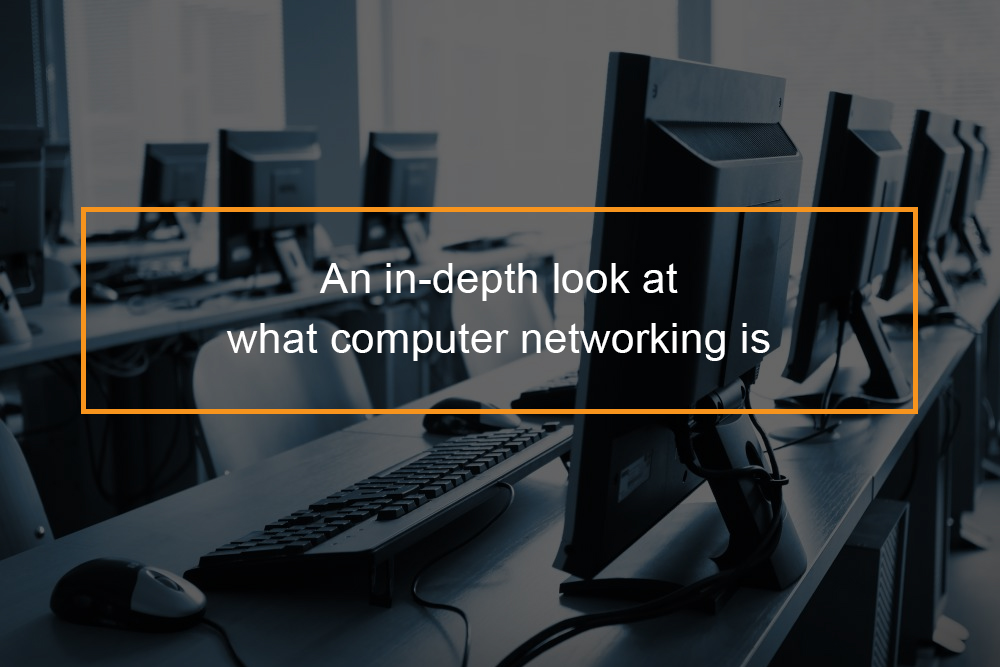
Computer networking is the practice of interfacing two or more computing devices to share data. They are built with a combination of hardware and software.
What is Computer Networking?
The definition of computer networking
A computer, or data network, is a digital telecommunications network that lets devices share resources. They exchange data with each other using connections (data links) between nodes. These data links are made over cable media such as wires or optic cables, or wireless media such as WiFi. It can also be defined as an engineering discipline that studies and analyzes the communication process among various devices or computer systems linked together to exchange information and share resources. A router, a network card, and protocols are the fundamental pillars upon which any network is based. They are the backbone of modern-day communication. Most telephony services are also working with IP. The increase of communication has led to advancement in the networking field and in industries like hardware, software manufacturing, and integration.
What are Network Nodes?
Network computer devices that begin, route and terminate the data are called network nodes. They are identified by network addresses which can include hosts such as PCs, phones, servers as well as other networking hardware. Two such devices are networked together when one device can exchange information with the other, whether or not they have a direct link to each other. In most cases, application-specific interaction protocols are layered (i.e., carried as payload) over other more general communications protocols. This collection of information technology requires skilled network management to keep it all running.
Computer networks support a vast number of programs and services such as access to the World Wide Web (WWW), digital video and audio, shared utilization of application and storage servers, printers, and use of email and instant messaging (IM) applications, etc. Computer networks differ in:
- The transmission medium used to convey their signals
- Communications protocols to standardize network traffic
- The network’s size, topologies, traffic control mechanisms, and organizational intent.
The best-known computer network is the Internet.
Components of a computer network
Computer network basics
Apart from any physical transmission media like computers, networks comprise additional system building blocks, like network interface controllers (NICs), repeaters, hubs, switches, routers, modems, bridges, and firewalls. Any piece of equipment will often contain multiple building blocks and perform multiple functions.
Network interfaces
A network interface controller (NIC) is a piece of computer hardware that can access the transmission media and can process low-level network information. For instance, the NIC may have a port for a cable, or an aerial for wireless transmission and reception, and the linked circuitry. It responds to traffic directed to a network address for either the NIC or the computer.
In Ethernet networks, each NIC has a one of a kind Media Access Control (MAC) address, usually stored in the controller’s permanent memory. This is done to avoid address conflicts between the devices, The Institute of Electrical and Electronics Engineers (IEEE) controls and gives MAC address uniqueness, and it is six octets long. The three most significant octets are used to identify NIC manufacturers. They, in turn, using only their assigned prefixes, assign the three least-significant numbers of every NIC made.
Repeaters and hubs
It is an electronic machine that receives a network signal, scrubs it of unnecessary noise and transmits it. The signal is stronger or to the other side of whatever is obstructing it reducing signal degradation no matter the distance. In most twisted pair Ethernet arrangements, repeaters are needed for cables that run longer than 100 meters. With fiber optics, they can be tens or even hundreds of kilometers apart. A repeater with many ports is known as an Ethernet hub. They work on the physical layer of the OSI (open systems interconnection) model and need a small amount of time to clean and transmit the signal. This can result in a propagation delay affecting network performance and function. Thus, many network architectures limit the number of repeaters that can be used in a row, for example, the Ethernet 5-4-3 rule. Hubs and repeaters in LAN networks have been mostly phased out by switches.
Bridges
It connects and filters traffic between two network segments at the data link layer of the OSI model to form a single network. This reduces the network’s collision domain but keeps a unified broadcast domain. Network segmentation divides a large, congested network into a collection of smaller, more efficient networks.
There are three types of bridges:
- Local bridges: Directly connect LAN networks
- Remote bridges: Are used to create a wide area network (WAN) connection between LANs. Remote bridges where the connective link is slower than the end networks have been substituted with routers.
- Wireless bridges: They can be utilized to join LANs or connect distant devices to LANs.
Switches
It is a device that forwards and filters OSI layer two datagrams (frames) between ports based on the target MAC address in each frame. A switch differs from a hub as it only transmits the data to the physical ports included in the communication rather than to all the connected ports. It can be viewed as a multi-port bridge. It learns to link physical ports to MAC addresses by analyzing the source addresses of received frames. If an unknown address is targeted, the switch transmits to all ports except the source. They normally have many ports, facilitating a star topology for devices, and cascading additional switches.
Routers
A router is an internetworking apparatus that forwards data packets between networks by processing the routing information in the packet or datagram (Internet protocol information from layer 3). This information is often processed in conjunction with the routing or forwarding table. A router uses its routing table to know where to forward packets. An address in a routing table can include a “null” interface, also known as the “black hole” interface because data can go in; however, no further work is done for said data, i.e., the packets are dropped.
Modems
Modems (MOdulator-DEModulator) connect network nodes via wire not originally designed for digital network traffic, or wirelessly. They achieve this with one or more carrier signals modulated by the digital signal to make an analog signal that can be customized to provide the needed properties for transmission. Modems are used for telephone lines, using a Digital Subscriber Line technology.
Firewalls
Firewalls control network security and access controls. Firewalls are typically configured to restrict access requests from unrecognized sources while allowing actions from recognized ones. The role firewalls play in network security grows in parallel with the constant increase in cyber attacks.
The architecture of a network
A network’s architecture is the design of a communication network. It is a framework for the specification of a network’s physical components and their functional organization and configuration, its operational principles and procedures, as well as data formats used. A network’s topology is the arrangement of the various elements (links, nodes, etc.) of a computer network. Essentially, It is the layout or organizational hierarchy of interconnected nodes of a computer network and can be depicted physically or logically. Different network topologies can affect output, but reliability is often more critical. With various technologies, such as bus networks, a single malfunction can cause the network to fail. In general, the more connections there are, the more robust the network is; but also the more expensive it is to install.
Common network topologies
A list of commonly used layouts
Listed below are the common network layouts:
A bus network: all nodes are linked to a common medium along this network. This was the design used in the original Ethernet, called 10BASE5 and 10BASE2. It is still a common topology on the data link layer, although modern physical layer alternatives use point-to-point connections instead.
A star network: all parts are connected to a specific central node. This is the layout found in a Wireless LAN, where each wireless device connects to the central WAP (wireless access point).
A ring network: each machine is connected to its right and justify neighboring node, such that all nodes are joined, and they can reach each other by traversing nodes justify- or rightwards. The Fiber Distributed Data Interface (FDDI) utilizes such a topology.
A mesh network: every node is connected to an arbitrary number of neighbors in such that there is at least one traversal link from any node.
A fully connected network: every node is linked to every other node in the network.
A tree network: nodes are arranged in a hierarchy.
Note that the physical layout of the devices in a network does not reflect the network topology. For example, with FDDI, the network’s topology is a ring (actually two counter-rotating rings), but the physical, topographical nature is a star because all neighboring connections can be routed via a central physical location.
Types of networks
The various categories of networks
A network can be defined by its physical capability or its organizational purposes like the use of the network, including user permission and access rights, differ accordingly. Networks can be categorized into two groups:
On a geographical scale
Listed below are some of those computer networks:
-
Nanoscale network
A nanoscale network has key elements implemented at the nanoscale which include message carriers and leverages physical principles that contrast from macroscale communication tools. Nanoscale communication reaches communication with very small sensors and actuators like those found in biological systems and tend to operate in environments that would be too harsh for traditional communication.
-
Personal area network
A personal area network (PAN) is a network used for communication among computers and different devices close to one person. Examples of machines that are used in a PAN are personal computers, printers, fax machines, telephones, etc. A PAN may have wired, and wireless devices and its reach typically extend to about 10 meters. A wired PAN is usually built with USB and FireWire links while Bluetooth and infrared communication make up a wireless PAN.
-
Local area network (LAN)
It is a network that joins devices in a limited geographical area such as a home, school, office building, or closely grouped buildings. Each device on the network is a node. Wired LANs are based on Ethernet technology. The defining properties of a LAN include higher data transfer speeds, limited geographic scope, and lack of reliance on rented lines to provide connectivity. A LAN can be linked to a WAN using a router.
-
Home area network (HAN)
It is a residential LAN used for interaction between digital devices in the home. An important feature is the sharing of Internet access, often a broadband service.
-
Backbone network
It is part of a computer network’s foundation that provides a path for the exchange of information between different LANs or sub-networks. A backbone can link diverse networks within the same building, across different buildings, or over a wide area. For example, the Internet is a backbone, which is the set of wide area networks (WANs) and core routers that join all networks connected to the Internet.
-
Metropolitan area network
A Metropolitan area network (MAN) is an extensive network that can span a city or a large campus.
-
Wide area network
A wide area network (WAN) is a system that covers a broad geographic area like a city, country, or extends to even intercontinental distances. It uses a communications channel that combines many types of media such as telephone lines, cables, and airwaves.
-
Enterprise private network
An enterprise’s private network is a network that a single organization builds to connect its various office locations (for instance, production sites, head offices, remote offices, shops) so they can share computer resources and information.
-
Virtual private network (VPN)
It is an overlay network in which some of the links between the nodes are carried by open links or virtual circuits in some larger network (e.g., the Internet) instead of by physical cables. The data link layer protocols of the VPN are tunneled through the larger network when this is the case. One common use is for secure communications through the Internet, but a VPN need not have specific security characteristics, such as authentication or content encryption. VPNs, for instance, can be used to isolate the traffic of different user communities over an underlying network with strong security features.
-
Global area network GAN
It is a network used for supporting mobile across an arbitrary number of wireless LANs, satellite coverage areas, etc. The principal challenge in mobile communications is handing off user communications from one local coverage area to the next resulting in many households having access to one or more networks.
On an organizational scope
The companies that own them manage these networks. Private enterprise networks may use a blend of intranets and extranets. They can also grant network access to the Net, which has no sole owner and permits virtually unlimited global connectivity.
-
Intranet
It is a set of networks that are controlled by a single administrative entity. It uses the IP protocol and IP-based tools such as web browsers and file transfer applications. The administrative entity limits the use of the intranet to its authorized users. Usually, an intranet is the internal LAN of a business. A large intranet has at least one web server to present users with organizational data. An intranet is also any system behind the router on a LAN.
-
Extranet
It is similar to an intranet but supports a limited connection to a specific external network. For instance, a company may provide access to some aspects of its intranet to share data with its business partners or customers.
-
Internetwork
An internetwork is the combination of multiple networks via a common routing technology utilizing routers.
-
Internet
It is the largest example of internet work. It’s a global system of linked governmental, academic, corporate, public, and private computer networks. Based on the networking tech of the Internet Protocol Suite, it succeeded the Advanced Research Projects Agency Network (ARPANET) made by DARPA. The Internet is also the information backbone underlying the World Wide Web (WWW).
Users of the Internet use a wide range of methods of several hundred documented, and often standardized, protocols harmonious with the Internet Protocol Suite and an IP address given by the Internet Assigned Numbers Authority and address registries. ISP providers and large enterprises swap information about the reachability of their address through the Border Gateway Protocol (BGP), forming a tautological worldwide mesh of communication paths.
-
Darknet
It is an overlay network, running on the Internet, that is only accessible with specialized software. Darknet is an anonymizing network where links are made only between trusted peers using non-standard protocols and ports. Darknets are distinct from other shared peer-to-peer networks as sharing is anonymous, and hence the users can talk with little fear of governmental or corporate interference.
Utilization of a computer network
The uses of a computer network
Computer Networks with some traditional uses in companies and for people and then advance to the recent advancements in the area of mobile users and home networking.
Computer Networks: Business uses
The following are some business applications of networks:
Information and Resource Sharing: They allow organizations to share information in a very effective manner between different departments. Other computers linked to the system can access programs and software in any computer. It also permits the sharing of hardware, like printers and scanners among varied users.
Accessing Remote Information: Through computer networks, users can access remote data on a variety of topics. The information is in remote databases where the user gets access through information systems like the Web.
Fast Interpersonal Communication: Computer networks have increased the speed and volume of communication. Electronic Mail (email) is widely used for sending texts, documents, images, and videos across the globe. Online communications have increased greatly through social networking services.
E-Commerce: Computer networks have paved the way for business and commercial transactions online, popularly called e-commerce. Users and organizations can combine funds, buy or sell items, pay bills, manage bank accounts, pay taxes, transfer funds and handle investments electronically.
Highly Reliable Systems: Computer networks let systems be distributed in nature, storing data in multiple sources. This makes the system very reliable. In case of failure in one source then the system will continue to function, and the information will still be available from the other references.
Budget-friendly Systems: They have reduced the expense of establishing computer systems in companies. It was important for organizations to set up costly mainframes for computation and storage before but with the advent of networks, setting up interconnected personal computers (PCs) for the same purpose is enough.
VoIP: Voice over Internet protocol has transformed telecommunication systems. Telephone calls are made digitally using Internet Protocols instead of the regular analog phone lines.
Computer Networks: Home Uses
Some of the most well-known uses of the Internet for home users are as follows:
- Access to remote information
- Person-to-person communication
- Interactive entertainment that connects devices like VR headsets, smart Tv’s, etc.
- E-commerce by shopping online
Computer Networks: Mobile Users
Mobile users like those using laptops and smartphones, make up one of the fastest-growing sections of the computer industry. Even though wireless networking and mobile computing are often associated, they are not identical.









